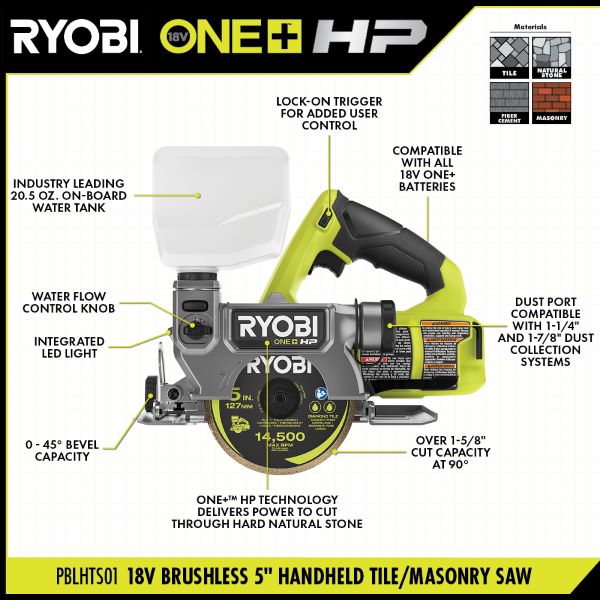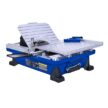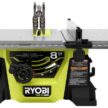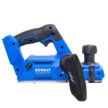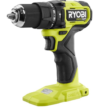RYOBI 18V Handheld Tile/Masonry Saw
RYOBI 18V Handheld Tile/Masonry Saw
RYOBI has just released their 5-inch cordless 18V Handheld Tile/Masonry Saw (Model PBLHTS01B), part of their 18V ONE+ lineup. It joins the earlier RYOBI corded handheld tile/masonry saw with a 4-inch blade. This new tool brings RYOBI into the cordless tile/masonry saw fold, a relatively new class of tool.
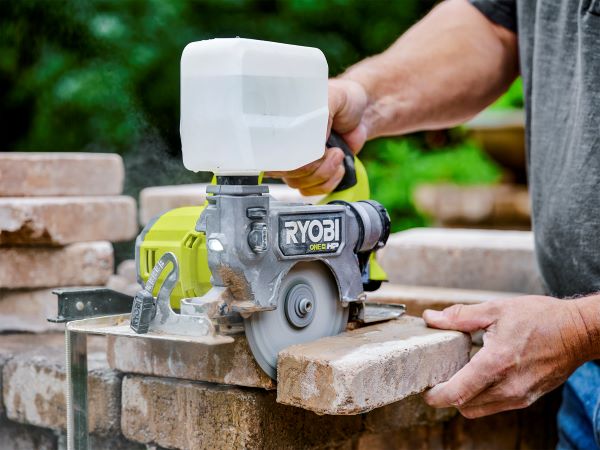
The Place of a Handheld Tile/Masonry Saw.
This raises the question: Where does a handheld tile/masonry saw fit into the scheme of things, and where does a cordless version, such as this 18V Handheld Tile/Masonry Saw, of same fit?
First, why cordless? I tend to prefer corded tools when you are bringing the workpiece to the tool so that I don’t have to think about battery management. Conversely, I prefer cordless tools when you bring the tool to the workpiece, because running moving cords all over a worksite is both a pain and dangerous.
I see a handheld tile/masonry in relation to a fixed tile/masonry saw more or less the same way I see a circular saw in relation to a table saw. The table saw is fixed, corded, and used for precise cuts. The circular saw is mobile, cordless, and used for less precise cuts on generally larger pieces. Of course either saw can be used for either task, just not as easily.
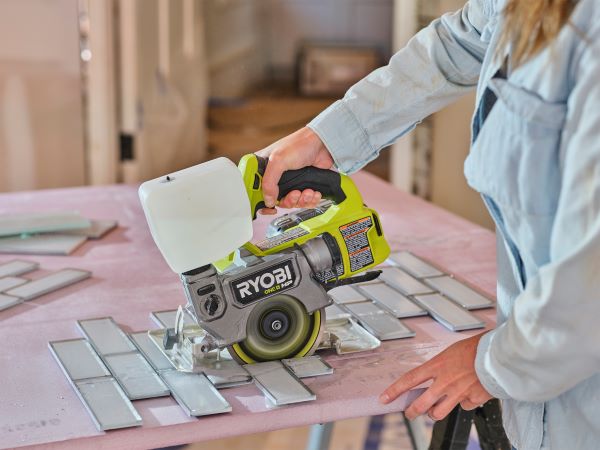
Likewise, I see a fixed tile/masonry saw used for most interior tiling jobs where precision is important and the size (format) of the tiles is relatively small. A cordless handheld tile/masonry saw finds its niche, to my mind, in exterior work with larger or rougher tiles, pavers, and stones, and some interior work like cutting cement board. Hardscaping is a perfect example. Of course it can also be used to cut smaller, more finished tiles if you exercise care. It may also be the right – indeed the only — tool to cut large format stone – think countertops.
Of course, you can use an angle grinder or a standard circular saw with the appropriate blade to cut tile and masonry material. Both put out copious amounts of bad-for-you dust, which will also get into the gearing and motor of a circular saw. A proper, purpose-designed tool like the RYOBI 18V Handheld Tile/Masonry Saw is the way to go.
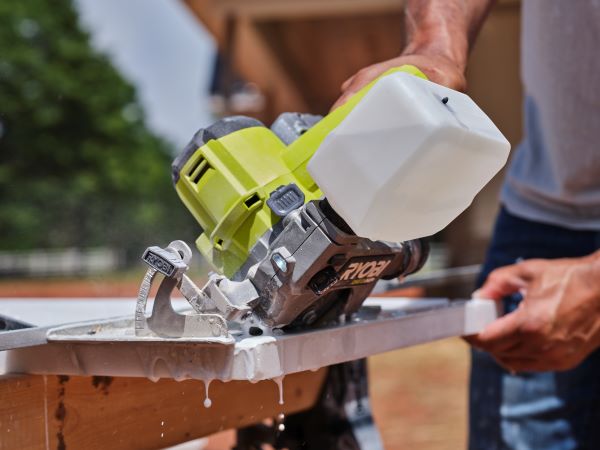
Specs
- Can cut over 100 linear ft. per charge using a 12.0 Ah battery on 1/4 in. tile
- Over 1-5/8 in. cut capacity at 90° provides the ability to cut 1-1/2 in. pavers in a single pass
- 5 ounce on-board water tank for dust reduction
- 5-inch blade
- 7/8-inch arbor
- 10,500 rpm motor
- 12 ft. water supply hose included for unlimited water flow
- Water flow control knob
- Lock-on trigger
- 0 – 45° bevel capacity
- Dust port compatible with 1-1/4 in. and 1-7/8 in. dust collection systems
- Integrated LED light
- Part of the RYOBI 18V ONE+ System of over 280 Cordless Products
- 3-Year Manufacturer’s Warranty
- Tool-only version includes: 18V Handheld Tile Saw, 12 ft. Water Supply Hose, 20.5 oz Water Tank, 5 in. Diamond Cutting Blade, Arbor Wrench, and Operator’s Manual
- PBLHTS01B, $199 at The Home Depot
First Impressions – All Good
The saw feels substantial all around: the polymer body, the aluminum motor housing, and the (steel, I think) shoe. Controls are ergonomic, including the water-flow valve adjustment (so you can adjust the flow as you cut). The over-molded handle is comfortable and grippy. The 0-degree and 45-degree bevel settings were spot on. The tool is spec’ed at 7.3 pounds and is balanced well, even with batteries ranging from 2Ah to 6Ah in size.
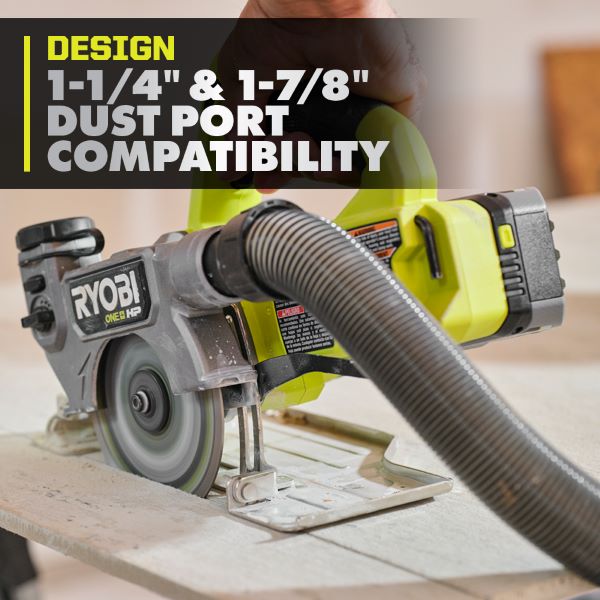
Set-up
The assembly and set-up of the RYOBI 18V Handheld Tile/Masonry Saw couldn’t be easier. It consists of little more than putting the provided blade on the arbor. Setting up the on-board water tank or the garden hose-fed continuous water supply is basically plug-and-play. Five minutes max.

Cutting Stuff
You can operate this saw in three modes: dry cutting — preferably with the vacuum hose connection to manage the dust, wet cutting with the on-board water tank, and wet cutting using the continuous hose-fed water supply. You really want to wet-cut masonry material if you can. Not only does the dust go literally everywhere, but it’s dangerous to breathe. I verified that the garden hose feed worked with this saw, but used the far more convenient water tank for all my test cuts.
I also stuck with the factory-supplied blade, but it’s important to keep in mind that the speed and quality of a cut in any material is dependent on the correct blade being used. This is particularly true with stone, cement, and ceramic materials since there are specific blades made for each of them, and these blades vary considerably in design, materials, and quality. So what follows, using the supplied generic blade, is just a suggestion of the RYOBI 18V Handheld Tile/Masonry Saw’s capabilities.

I found that I could cut 1/4-inch tile (ceramic and porcelain) at the speed that I’d make a careful cut in wood with a circular saw. That’s as fast as I ever want to cut masonry material anyway, since, unlike cutting wood, you can’t make slight adjustments to the cut line as you go – you have to make sure you’re tracking your line all the time. Since this is a blade-left saw, keeping track of your cut line is easy for a right-handed operator cutting to their right if you’re making a 0-degree cut. When making a 45-degree bevel cut though, this line-of-sight is blocked; you’ll have to set up carefully and index the cut to the scale at the front of the shoe.
The manual suggests that you cut tile good side down, which makes sense given the rotational direction of the blade. But in making my test cuts I had the good side up. The resulting cuts (see image below) were still very smooth with barely noticeable chipping. For real work though, I’d stick to good side down.

Cutting fresh bricks and 1.5x8x16-inch cement blocks, both dry and wet, I could cut at the rate that was what I’d expect for a hand-held saw, taking a couple/few seconds per inch depending on the material. This was quite satisfactory and was well in line with expectations.
Moving onto very well-cured bricks and concrete (they’d been outside for probably close to 20 years), cutting went more slowly, but smoothly. If I pushed too hard, of course, I could stall the saw, but that’s true of any saw in any material.

If you’re cutting tile or doing your own hardscaping, just take your time and you’ll be OK. This saw doesn’t slow down or strain as the cut gets harder – it just stalls, so you’ll have to find the cut rate that works for your material and stick to it.
Wet Cutting
As I mentioned, you really want to cut tile and masonry wet if possible. I don’t really care for attaching a water hose to a saw like this because it ties me to a location and just gets in the way (YMMV). Using the supplied water tank, however, is ease-of-use exemplified. At the max flow rate you will deplete it after several minutes of cutting, but just keep a five-gallon bucket of water handy to refill it in.
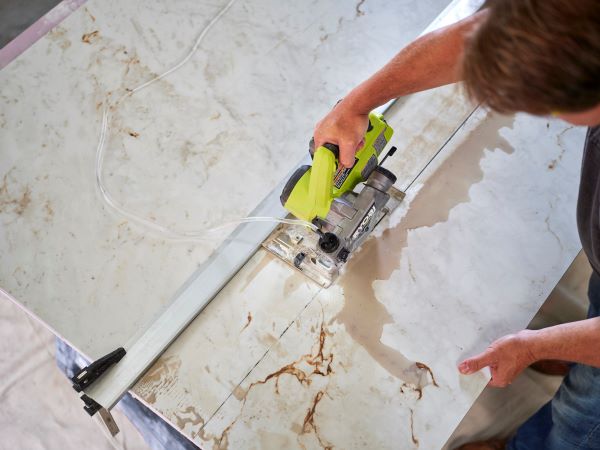
Really, Really IMPORTANT
All diamond blades come with a maximum rpm rating. You do not – do NOT – want to run them faster than that. Make SURE your blade’s rpm rating is more than the rpm of the motor to which it’s attached. If you don’t, the blade will shatter and send sharp shards in all directions – including toward you – at high speed. Any part of you that’s not covered by Lexan or Kevlar will suffer severe lacerations. So don’t do that! Also, the manual warns against using segmented blades with this saw – stick to continuous rim blades.
Further, this saw is not designed for a concave blade, so you can’t cut curves with it (that’s a significantly more advanced feature in a tile saw).
Bottom Line
The RYOBI 18V Handheld Tile/Masonry Saw is a really handy tool to have in your tool armory. It’s what you need for long cuts on large or long format tiles, and it will handle many common masonry hardscaping materials if you take your time. While it doesn’t have a front pommel grip, I didn’t find I needed one, and in any case it’s easy enough to just grasp the front of the motor housing if you need that specific stability for any particular cut. It will fill a niche for all trades types.



